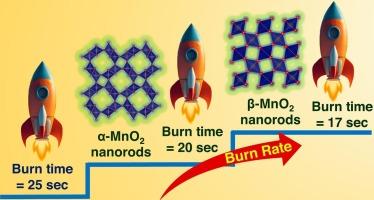二氧化锰纳米棒的晶型缺陷化学:晶界和氧空位对固体推进剂燃烧速率增强的影响
IF 6.9
2区 材料科学
Q2 CHEMISTRY, PHYSICAL
引用次数: 0
摘要
通过缺陷和界面工程,控制合成具有定制形态和晶体结构的纳米材料已成为优化催化性能的关键策略。二氧化锰(MnO2)是一种过渡金属氧化物,具有多种多晶态,具有不同的原子框架和可调的缺陷化学性质,是研究结构-性能-性能相关性的理想化合物。本研究合成了α-和β-MnO2纳米棒,并对其进行了系统评价,以阐明晶体结构、晶界和氧空位对催化行为的影响。x射线光电子能谱(XPS)和高分辨率透射电镜(HRTEM)分析显示,β-MnO2相表现出优异的催化活性,这是由于其丰富的高能晶界界面和表面氧空位浓度升高所致。相依赖的结构特征和表面缺陷调节Mn氧化环境,产生不饱和配位,促进反应物吸附和键激活。这些位点作为高活性中心,促进反应物吸附和键活化,从而提高催化活性,大大加快复合固体推进剂的燃烧动力学。这些由结构修饰驱动的催化增强导致高氯酸铵(AP)的分解加速,并提高了AP基复合固体推进剂的燃烧速率。本文章由计算机程序翻译,如有差异,请以英文原文为准。

Polymorph‒dependent defect chemistry of MnO2 nanorods: grain boundary and oxygen vacancy effects on burn rate enhancement in solid propellants
The controlled synthesis of nanomaterials with tailored morphologies and crystal structures has emerged as a key strategy for optimizing catalytic performance through defect and interface engineering. Manganese dioxide (MnO2), a transition-metal oxide, existing in multiple polymorphs with distinct atomic frameworks and tunable defect chemistries, is an ideal compound to investigate structure–property–performance correlations. In this study, α- and β-MnO2 nanorods were synthesized and systematically evaluated to elucidate the influence of the crystal structure, grain boundaries, and oxygen vacancies on the catalytic behavior. The β-MnO2 phase demonstrated superior catalytic activity, which was attributed to its abundant high-energy grain boundary interfaces, and elevated concentrations of surface oxygen vacancies, as revealed by X-ray photoelectron spectroscopy (XPS) and high-resolution transmission electron microscopy (HRTEM) analyses. Phase-dependent structural features and surface defects modulate the Mn oxidation environment and generate unsaturated coordination sites that facilitate reactant adsorption and bond activation. These sites serve as highly active centers that promote reactant adsorption and bond activation, thereby enhancing the catalytic activity and substantially accelerating the combustion dynamics of composite solid propellants. These catalytic enhancements driven by structural modifications resulted in the accelerated decomposition of ammonium perchlorate (AP) and an enhanced burn rate in AP-based composite solid propellants.
求助全文
通过发布文献求助,成功后即可免费获取论文全文。
去求助
来源期刊

Applied Surface Science
工程技术-材料科学:膜
CiteScore
12.50
自引率
7.50%
发文量
3393
审稿时长
67 days
期刊介绍:
Applied Surface Science covers topics contributing to a better understanding of surfaces, interfaces, nanostructures and their applications. The journal is concerned with scientific research on the atomic and molecular level of material properties determined with specific surface analytical techniques and/or computational methods, as well as the processing of such structures.
 求助内容:
求助内容: 应助结果提醒方式:
应助结果提醒方式:


